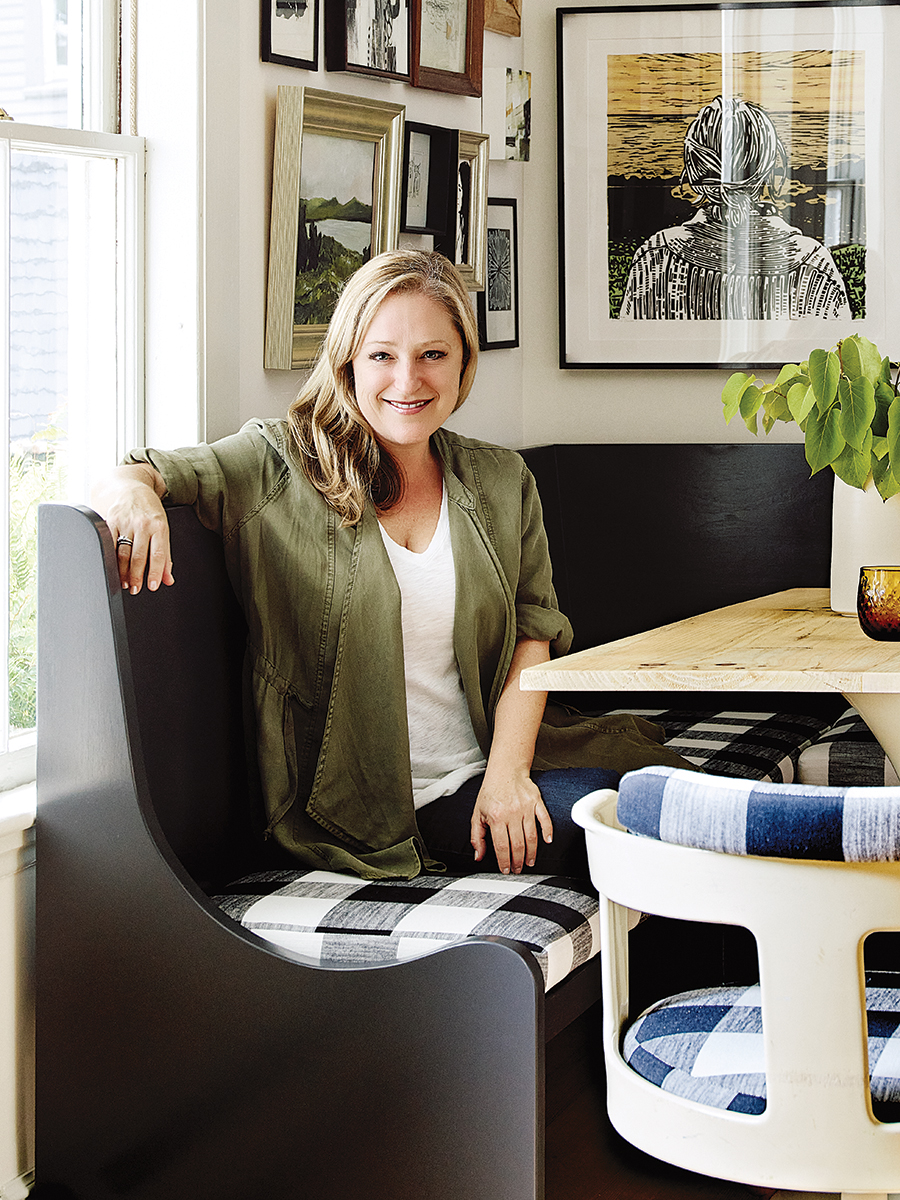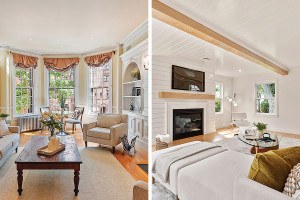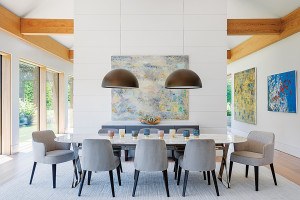What’s It Like to Host HGTV’s Farmhouse Fixer with NKOTB Alum Jonathan Knight?
Interior designer Kristina Crestin dishes on her new TV series, favorite podcast, and the satisfaction of doing work you love.

Interior designer Kristina Crestin takes a seat in a Gloucester home featured on Farmhouse Fixer. / Photo by Jared Kuzia
Kristina Crestin has accomplished a lot since the early aughts. Graduated from Endicott College and landed a job at lauded firm Siemasko + Verbridge? Been there. Bid her mentors adieu to launch her own interiors company several years later? Done that. And now, after celebrating her firm’s 11th anniversary last fall, the seasoned designer gains another feather in her creative cap: starring opposite New Kids on the Block alum (and fellow North Shore resident) Jonathan Knight in a new HGTV show, Farmhouse Fixer. Set locally, the six-episode series, which debuted in March, follows the pair as they breathe new life into old homesteads. “I feel like the work is really layered and done,” says Crestin, who caught up with us before the series premiere. “I’m really excited [to show that].”
You and Jonathan have known each other for a while. How did you meet?
It was sometime around 2004, when I was working at Siemasko + Verbridge [now SV Design] right out of college. Jon had hired the firm to do some architecture in his own house, so I met him then. We really clicked, and kind of stayed in touch [after the job ended]. Fast-forward many years to when I did a season of This Old House [in 2016], Jon sent me a text at, like, 3 in the morning. He said something along the lines of, “Oh my God, I just realized it’s you [on the show]. I’m so proud of how far you’ve come and what you’re doing.” It was so sweet.
How did you team up for Farmhouse Fixer?
Jon had been trying to get the show on the air for a while, and when he [connected with] High Noon Entertainment—the production company—and HGTV, they [suggested finding a designer] he could play off. At that point, he [recommended me]. [Eventually,] I got a call from the production company asking if I would be interested in a show they were developing. I think This Old House helped give me legitimacy as a possible TV personality. So [High Noon] threw us together to do a proof of concept. Then we found out we got a pilot, and the rest is history.
You typically work on coastal projects. Has focusing on farmhouses felt like an adjustment?
So I’ve been trying to get into farmhouses [for a while]. I swear, I had been trying to find a developer who wants to do modern farmhouses for eight, 10 years before they were a thing. I could never find somebody. I’ve always wanted to do eclectic ones like the farmhouses in upstate New York, which [are different] from [what we have] here. The fact that this opportunity popped up is kind of weird. I love coastal projects and I want to keep doing them. But working on farmhouses very much requires different brain parts when it comes to detailing, and I love the juxtaposition of the two [aesthetics]. This is the design work I’ve been wanting to feed my soul.
That’s very exciting!
Thank you. It’s weird to have these moments to think, I’m really happy. One day, I was driving to a job site and Nickelback’s “If Today Was Your Last Day” came on the radio. I hate to admit this, but I love Nickelback. The lyrics [to that song] are really good, and I listened to them the day I quit Siemasko + Verbridge. There’s no drama about quitting; it was just the day I was finally choosing to move on. So the song comes on, and I start crying. I thought, I’m just happy—even though there’s a pandemic. I’ve worked my ass off, and I’m pleased with where I am. The other day, a builder [I’m working with] said, “You’re so lucky.” And then the client said, “No, no. She’s worked hard to be prepared to be lucky.”
A very important distinction.
Yeah, it’s a hard thing. Looking at others who have had success, I think it’s so easy for people to discount how they got there. That’s why I love listening to business podcasts. My favorite is LuAnn Nigara’s A Well-Designed Business. I just like hearing about people’s processes and their steppingstones—what they did and what they’ve gone through.
Speaking of processes, what’s it like to partner with Jonathan?
I basically design everything, and Jon—the renovation expert—hosts the show and guides the audience through what’s happening. It’s fun to work with somebody whose passion for old houses is contagious. My favorite days are when I’m staging a house, and he’ll walk in. Most of the time, he almost cries. That can be better than the homeowner’s reaction because he’s so invested in the house and I can see how proud he is of it. I look forward to that moment of having him see how everything came together.
Have you learned anything about yourself as a designer from being on the show?
It’s been massively illuminating. I have learned that your first answer many times is right. I think that’s helped me move the ball faster. It’s okay to make a decision without looking at 52 options. Working on the fly still produces great design.
The show has also really upped my styling ability. [In my practice], sometimes when we have a client that’s hired us to both build or renovate and decorate, we get the project to 80 percent before the client has decision fatigue. I don’t get a lot of projects finished all the way. [With the show], I had to finish them come hell or high water, and styling has been so fun in really bringing every project to the end. [For one episode], we worked on this very Ralph Lauren equestrian property where we had to fill bookcases without anything from the client. The night we were styling, I had one of my staffers on Facebook Marketplace looking for used books, and she found somebody with all these books in Salem. It was around 7 o’clock, and I’m like, “You go to Salem and bring them back tomorrow morning.” [Laughs.] That’s the piece that was important, though: I wanted to get to that layer [of design]. I hope people will notice that.
Any parting advice for viewers tackling their own farmhouse overhauls?
I feel like the first step is acknowledging how far you have to go. [That’s where] we’ve really had to educate homeowners. It’s not a basic renovation when you invest in an older house. It seems crazy that a casual farmhouse would cost more to renovate, but it can when you need to layer on beams or authentic, old-looking cabinetry, for example. Be prepared to pay for the extra materials and details.


